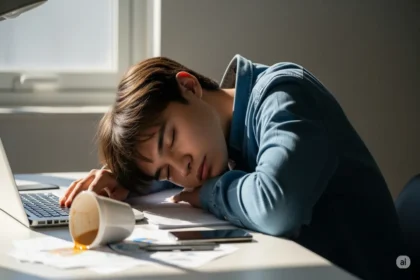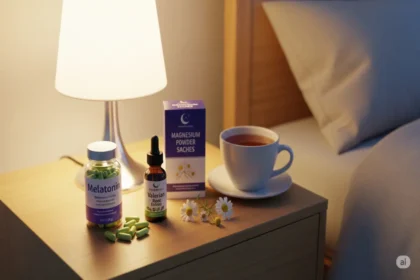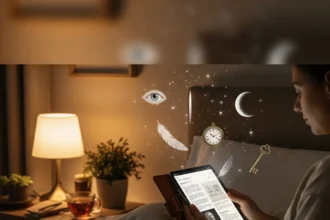The modern bedroom, for many, has become a battleground. The relentless demands of the day, the endless scroll of digital screens, and the pervasive hum of anxiety often follow us beneath the covers, turning the quiet hours of the night into a frustrating struggle for rest. We toss, we turn, our minds race, and the elusive peace of sleep seems forever out of reach. Yet, a growing body of scientific evidence suggests that one of the most powerful tools for reclaiming our nights lies not in external aids, but within ourselves: through the practice of Mindful Sleep. By harnessing the ancient wisdom of meditation and the simple power of our breath, we can learn to quiet the mental chatter, soothe the nervous system, and gently guide ourselves into a deeper, more restorative slumber.
The Science of Sleeplessness: An Overactive Mind
At its core, much of our difficulty falling asleep stems from an overactive sympathetic nervous system – the “fight or flight” response. When we’re stressed, anxious, or simply overstimulated, our bodies are primed for action, not rest. Cortisol and adrenaline surge, keeping us alert and vigilant. Our minds ruminate on past events or future worries, creating a constant internal dialogue that is antithetical to the calm required for sleep.
Sleep, on the other hand, requires the activation of the parasympathetic nervous system – the “rest and digest” system. This system slows heart rate, relaxes muscles, and reduces brain activity, paving the way for slumber. The challenge for many is making this crucial shift from sympathetic dominance to parasympathetic calm. This is precisely where mindful practices, particularly meditation and breathing exercises, prove invaluable.
The Power of Mindfulness: Anchoring the Restless Mind
Mindfulness is the practice of bringing one’s attention to the present moment, without judgment. It’s about observing thoughts, feelings, and bodily sensations as they arise, rather than getting caught up in them. When applied to sleep, mindfulness helps to:
- Reduce Rumination: Instead of being swept away by anxious thoughts about the day or worries about tomorrow, mindfulness teaches us to observe these thoughts without engaging with them, allowing them to pass like clouds in the sky.
- Lower Physiological Arousal: By shifting focus from external stimuli or internal worries to the present moment (often anchored by the breath), mindfulness helps to calm the nervous system, reducing heart rate, blood pressure, and muscle tension.
- Cultivate Acceptance: A significant barrier to sleep is the frustration and anxiety that arise when we can’t fall asleep. Mindfulness fosters an attitude of acceptance, reducing the “trying too hard” paradox that often keeps us awake.
Scientific research consistently supports the efficacy of mindfulness for sleep. Studies published in journals like JAMA Internal Medicine have shown that mindfulness-based stress reduction (MBSR) programs can significantly improve sleep quality, reduce insomnia symptoms, and alleviate daytime fatigue in older adults. The mechanism is believed to be through reducing arousal and rumination, which are key drivers of sleeplessness.
Breathing Exercises: The Direct Pathway to Calm
Our breath is an incredibly powerful, yet often overlooked, tool for regulating our nervous system. Unlike our heart rate or digestion, our breath is both involuntary and voluntary. We can consciously control it, and by doing so, we can directly influence our physiological state. Slow, deep, rhythmic breathing activates the vagus nerve, a major component of the parasympathetic nervous system, signaling to the body that it’s safe to relax.
Here are some simple, yet highly effective, breathing exercises to guide you towards sleep:
1. The 4-7-8 Breathing Technique (Dr. Andrew Weil’s Method)
This technique is based on an ancient yogic practice and is designed to relax the body and mind by increasing oxygen to the parasympathetic nervous system. It’s often described as a “natural tranquilizer for the nervous system.”
- How to do it:
- Place the tip of your tongue against the ridge of tissue just behind your upper front teeth, and keep it there through the entire breathing exercise.
- Exhale completely through your mouth, making a gentle “whoosh” sound.
- Close your mouth and inhale quietly through your nose to a mental count of four.
- Hold your breath for a count of seven.
- Exhale completely through your mouth, making a “whoosh” sound, to a count of eight.
- This completes one breath. Inhale again and repeat the cycle three more times for a total of four breaths.
- Scientific Insight: The extended exhalation in this technique helps to slow the heart rate and promote relaxation. The breath retention allows for more oxygen to enter the bloodstream, further calming the nervous system. Regular practice can train your body to relax faster.
2. Diaphragmatic (Belly) Breathing
Many of us are “chest breathers,” taking shallow breaths that keep us in a state of mild tension. Diaphragmatic breathing, also known as belly breathing, involves engaging the diaphragm, a large muscle located at the base of the lungs, for deeper, more calming breaths.
- How to do it:
- Lie on your back with one hand on your chest and the other on your belly, just below your rib cage.
- Inhale slowly and deeply through your nose, feeling your belly rise with your hand. Your chest should remain relatively still.
- Exhale slowly through your mouth, feeling your belly fall. Gently contract your abdominal muscles to push out the last bit of air.
- Repeat for 5-10 minutes, focusing on the gentle rise and fall of your belly.
- Scientific Insight: This technique directly stimulates the vagus nerve, promoting parasympathetic activity. It also helps to oxygenate the blood more efficiently, reducing the physiological arousal that hinders sleep.
3. Box Breathing (Tactical Breathing)
Popularized by Navy SEALs for stress management, box breathing is a simple, rhythmic technique that can quickly calm the nervous system.
- How to do it:
- Exhale completely to a count of four.
- Hold your breath for a count of four.
- Inhale slowly to a count of four.
- Hold your breath for a count of four.
- Repeat the cycle, creating a “box” with your breath. Focus on the counts and the sensation of the breath.
- Scientific Insight: The equal counts create a predictable rhythm that helps to regulate heart rate variability, a key indicator of nervous system balance. This rhythmic pattern signals safety to the brain, allowing it to disengage from hyper-vigilance.
Simple Meditation Practices for Sleep
Beyond specific breathing exercises, broader meditation techniques can prepare the mind for sleep.
1. Body Scan Meditation
This practice involves systematically bringing awareness to different parts of your body, noticing any sensations without judgment. It helps to release physical tension and anchor your mind in the present moment, away from racing thoughts.
- How to do it:
- Lie comfortably in bed. Close your eyes.
- Start by bringing your attention to your toes. Notice any sensations – warmth, coolness, tingling, pressure. Don’t try to change anything, just observe.
- Slowly move your attention up your body: to your feet, ankles, calves, knees, thighs, hips, abdomen, chest, back, fingers, hands, arms, shoulders, neck, face, and finally the top of your head.
- As you move, notice any tension and, on the exhale, imagine that tension softening and releasing. If your mind wanders, gently guide it back to the part of the body you are focusing on.
- Scientific Insight: Body scan meditation enhances interoception (awareness of internal bodily states), which can help calm the nervous system. It also promotes muscle relaxation and shifts attention away from cognitive arousal.
2. Guided Imagery/Visualization
This involves focusing your mind on a peaceful, calming scene or experience, engaging all your senses.
- How to do it:
- Lie comfortably. Close your eyes.
- Imagine yourself in a place that brings you profound peace – a serene beach, a quiet forest, a cozy cabin.
- Engage your senses: What do you see (colors, light)? What do you hear (waves, birdsong, crackling fire)? What do you smell (salty air, pine, woodsmoke)? What do you feel (warm sand, soft moss, a cozy blanket)?
- Allow yourself to fully immerse in this imagined peaceful environment until you drift off.
- Scientific Insight: Visualization engages the brain’s imagination centers, diverting attention from stressful thoughts. It can also evoke the same physiological relaxation response as actually being in a calming environment.
Integrating Mindfulness into Your Bedtime Routine
The key to successful mindful sleep is consistency. These practices are not quick fixes but skills that improve with regular application.
- Practice Consistently: Even 5-10 minutes of practice each night can make a difference. The more you practice, the more easily your body and mind will respond.
- Be Patient and Non-Judgmental: It’s normal for your mind to wander, especially when you’re first starting. Simply notice when it happens and gently guide your attention back to your breath or the chosen exercise. Avoid frustration; that’s counterproductive.
- Create a Sacred Space: Ensure your bedroom is dark, quiet, and cool. This physical environment supports the mental shift towards relaxation.
- Disconnect from Screens: Avoid blue light and stimulating content from electronic devices for at least an hour before bed. This allows your brain to naturally produce melatonin.
- Listen to Your Body: Experiment with different techniques to find what resonates most with you.
Conclusion: The Gentle Path to Rest
In a world that constantly pulls us outwards, the practice of Mindful Sleep offers a gentle, powerful invitation to turn inwards, to reconnect with our breath, and to cultivate a state of calm that is conducive to deep rest. The science is clear: simple meditation and breathing exercises are not just ancient spiritual practices; they are evidence-based tools that can actively downregulate our stress response, quiet our racing minds, and guide us more swiftly and smoothly into the restorative embrace of sleep.
Reclaiming peaceful nights isn’t about fighting for sleep; it’s about surrendering to it. By learning to observe our thoughts without judgment and to harness the inherent calming power of our own breath, we unlock an inner genius for rest. It’s a journey towards profound tranquility, one mindful breath at a time, allowing us to wake up not just rested, but renewed, resilient, and ready to meet the day with a clearer mind and a calmer heart.
Disclaimer: The information provided in this article is for general informational purposes only and does not constitute medical advice. It is not a substitute for professional medical advice, diagnosis, or treatment. Always seek the advice of your physician or other qualified health provider with any questions you may have regarding a medical condition. Never disregard professional medical advice or delay in seeking it because of something you have read on this website.














